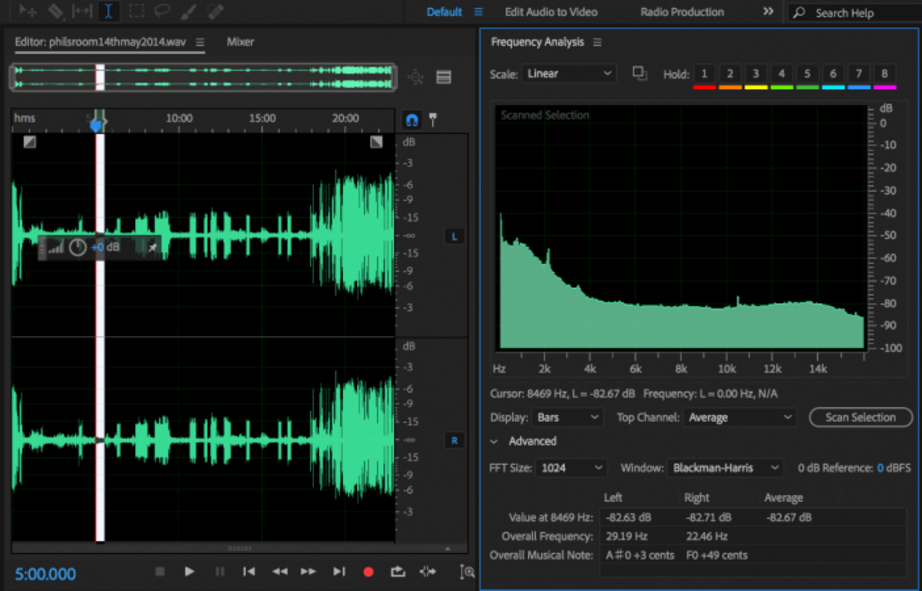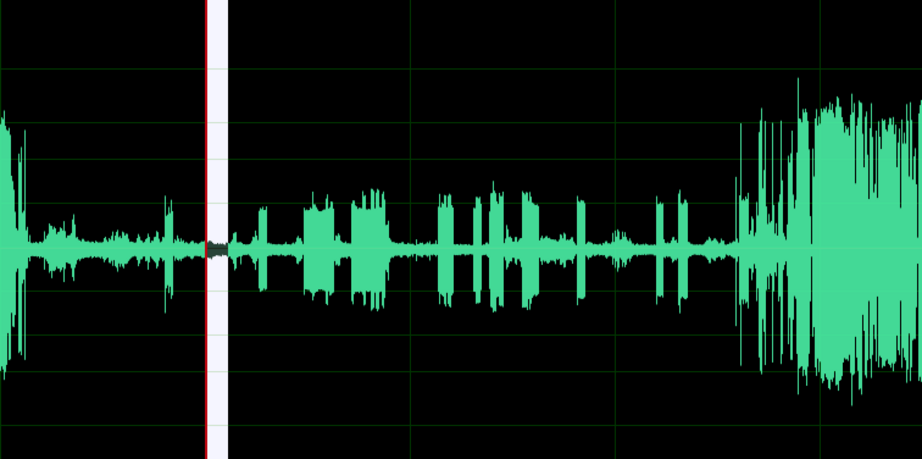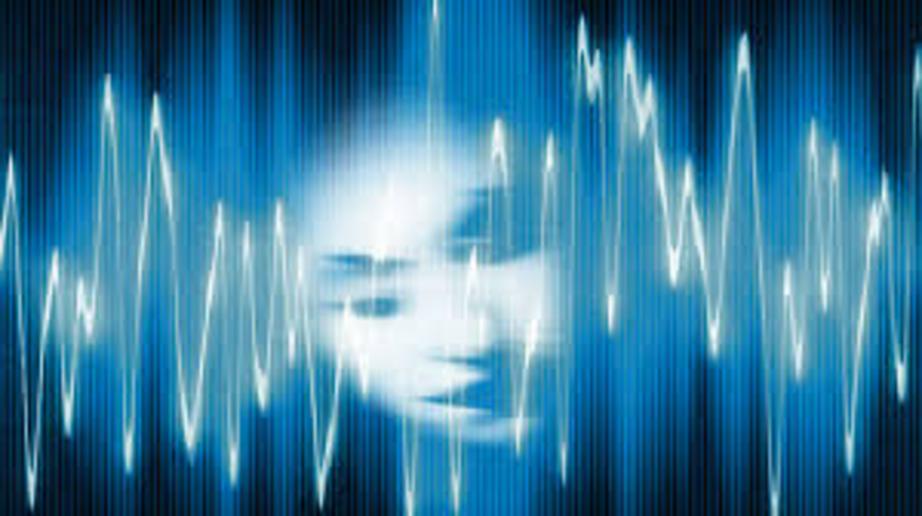EVP and frequency
How can you establish what frequency an EVP was captured at? Are there man made sources that can interfere with EVP? What is ELF? Is there a way to tell if a voice is human?
EVP is one of the most common techniques used across the world. There is actually a lot more to it than just pressing record and asking some questions. The work you do in analysing the EVP is equally if not more important than the session itself, starting with frequency. It is quite easy to find out in what frequency your potential EVP was captured. What do you do with this information and why is it useful?
Finding the frequency an EVP was recorded in
There is an array of software out there that allows you to analyse frequency and what frequency a sound was recorded in. One of the best programs to use is Adobe Audition. If this is too expensive, a lot of free programs such as audacity allow you to get this information as well. All you need to do is highlight the section of the file where you believe you have caught something and do a frequency analysis or a plot spectrum depending on which program you are using.

Now that you have this information, what do you do with it? The first thing is to eliminate anything that could potentially be a man made or natural frequency interferring with your recording.
Man Made Frequencies
(courtesy of paranormalwarehouse.com)
Man made frequencies can interfere with your recordings. Of course you are more likely to pick these up when using a ghost box (which is something to consider), it is also possible to pick these up during an EVP session.
- 225–420 MHz: Government use, including meteorology, military aviation, and federal two-way use
- 420–450 MHz: Government radiolocation and amateur radio (70 cm band)
- 433 MHz: Short range consumer devices including automotive, alarm systems, home automation, temperature sensors
- 450–470 MHz: UHF business band, General Mobile Radio Service, and Family Radio Service 2-way “walkie-talkies”, public safety
- 470–512 MHz: Low-band TV channels 14–20 (also shared for land mobile 2-way radio use in some areas)
- 512–698 MHz: Medium-band TV channels 21–51 (Channel 37 used for radio astronomy)
- 698–806 MHz: Was auctioned in March 2008; bidders got full use after the transition to digital TV was completed on June 12, 2009 (formerly high-band UHF TV channels 52–69)
- 806–824 MHz: Public safety and commercial 2-way (formerly TV channels 70–72)
- 824–851 MHz: Cellular A & B franchises, terminal (mobile phone) (formerly TV channels 73–77)
- 851–869 MHz: Public safety and commercial 2-way (formerly TV channels 77–80)
- 869–896 MHz: Cellular A & B franchises, base station (formerly TV channels 80–83)
- 902–928 MHz: ISM band, amateur radio (33 cm band), cordless phones and stereo, radio-frequency identification, data links
- 929–930 MHz: Pagers
- 931–932 MHz: Pagers
- 935–941 MHz: Commercial 2-way radio
- 941–960 MHz: Mixed studio-transmitter links, SCADA, other.
- 960–1215 MHz: Aeronautical radio-navigation
- 1240–1300 MHz: Amateur radio (23 cm band)
- 1452–1492 MHz: Military use (therefore not available for Digital Audio Broadcasting, unlike Canada/Europe)
- 1575 MHz: GNSS L1 band—GPS, GLONASS, Galileo
- 1710–1755 MHz: AWS mobile phone uplink (UL) operating band
- 1850–1910 MHz: PCS mobile phone—order is A, D, B, E, F, C blocks. A, B, C = 15 MHz; D, E, F = 5 MHz
- 1920–1930 MHz: DECT cordless telephone
- 1930–1990 MHz: PCS base stations—order is A, D, B, E, F, C blocks. A, B, C = 15 MHz; D, E, F = 5 MHz
- 2110–2155 MHz: AWS mobile phone downlink (DL) operating band
- 2300–2310 MHz: Amateur radio (13 cm band, lower segment)
- 2310–2360 MHz: Satellite radio (Sirius and XM)
- 2390–2450 MHz: Amateur radio (13 cm band, upper segment)
- 2400–2483.5 MHz: ISM, IEEE 802.11, 802.11b, 802.11g, 802.11n wireless LAN, IEEE 802.15.4-2006, Bluetooth, radio-controlled aircraft, microwave ovens
In order to avoid picking up on these frequencies, this is what a faraday shield is used for. Simply pop the recorder into a faraday pouch or a RF shielded box. This is also relevent for ghost boxes too.
ELF - Earth's Natural Noises
ELF stands for Earth's Natural Noises. The name is pretty self explanatory. Also known as VLF it is a very low frequency, that are radio signals from the Earth between around 200HZ and 10000HZ. These are not man made, they are created by nature. Lightening storms, Northern and Southern Lights, the earth's magnetic field all produce natural sounds such as whistling, chirping, barking and referred to as the 'Earth's music'. These can be recorded by your devices. Again a faraday pouch will protect your recordings from these interferences. This is why weird noises that you may receive on an EVP need to be thrown out. Unless it is a clear word, one would have to presume that it is some sort of interference either man made or natural.
Determining if speech is human
This information is also helpful in determining if the speech has come from a human voice box. There is no voice recognition software currently available that allows you to scan a file to determine if it is a human voice or not. You also then have to try to understand what is being said. Everyone talks differently which makes it difficult and is a problem that scientists refer to as 'The speech recognition problem' and is why there is no software that can do this for you. You can however analyse the waveform which will give you clues as to if it is human speech or perhaps something else.
First we have to get our heads around what is referred to as 'Voiced speech'. These are vowel like sounds that involve the use of the larynx. Other sounds such as S or T are not voiced as they rely on your tongue and mouth to produce the sound. The best way to determine which letters are voiced and which are not is to put your fingers to your throat and recite the alphabet. Voiced letters will make your throat vibrate because you are using your larynx to talk. It won't vibrate when using letters like S and T as again you are using your mouth to talk. It is also worth noting that when you whisper, you are not using your larynx just your mouth. Because voiced sounds rely heavily on vowels, they exist in almost every word so they are quite common. Most words with more than one syllable will at least include one voiced sound. Any sound made from the larynx is at a lower frequency and a higher sound and this can be identified by looking at the waveform in an editing program. If you look at the picture of a waveform below, you will notice that in each word, there are some areas which have a higher sound than others (the spike is higher). This means it is a voiced sound. (There are no EVPs in the below waveform, it is all human speech.

If you come across a potential EVP, look for evidence of these spikes, indicating it is a voiced word. Also look at the frequency of each letter in a word. Voiced sounds will be a lower frequency than unvoiced words. It means if a word has different frequency levels, it is most likely to be human. If a word only has the one frequency, it means that it is either not human or someone has whispered (as it is not getting that vibration of the larynx). Where it gets difficult is an EVP usually comes through as a whisper. If someone is whispering, it can be misinterpreted to be an EVP. It means that there is room for error when trying to determine if a whisper is human or not. This analysis is really just a guide, it is not set in stone and just because something doesn't follow the normal characteristics s of human speech doesn't mean it is necessarily paranormal. It is just clues for you to use an investigator.
It is up to you as the investigator to analyse all of the information. Look at the quality of your EVP. If it is anything less than Class A it should be thrown out. They do exist and they don't need any sort of editing. At the most you may want to amplify it, but beyond that, you shouldn't really be messing with the file. The more you mess with the file, the more you are tampering with it. What I always find to be interesting is that the human ear can hear between 20 to 20000 HZ. It is said that an EVP is caught outside of the range of what a human ear can hear. While this makes sense, you might bet interested to know that a lot of EVPs seem to be caught between 100-300HZ meaning that the human ear was capable of hearing it. If the human ear was capable of hearing it, why didn't we hear it? Is it because it is some sort of natural interference? Is it a case of psychic projection where we have acted as the 'ghost' and somehow put a word on tape? Is it that a spirit communicating through EVP is not so much about the HZ it is recorded and more about the act of putting the words on tape. Are they somehow manipulating the magnetic field and not the frequency and this is what an EVP is. We can speculate all day and the answer is that we really don't know. So the best approach when reviewing EVP is to rule out what it isn't - and that is natural interference as well as human interference. It's a tricky business, but it is all a part of being an investigator. It is not just about sitting in an empty room asking questions. How you review your evidence is equally and if not more important than the vigil itself. It is how you interpret and present the data that will ultimately matter.
Sound is a very complicated thing. The earth is all about vibrations and frequencies so it no surprise that the spirit world would use this to try and communicate with us. The hard part is determining, if the spirit world is actually trying to communicate with us, is it man made, is it natural or is it a form of audio pareidolia? The list goes on, but this puts the investigate into the word investigator. It's not meant to be straight forward, and it would be pretty boring if it was!
Don't forget to LIKE the Facebook page for updates on new content www.facebook.com/livinglifeinfullspectrum
Alot of the techincal information has been sourced from the book 'Voices from beyond' by Victor Mannahan and backed up with further research from other sources

